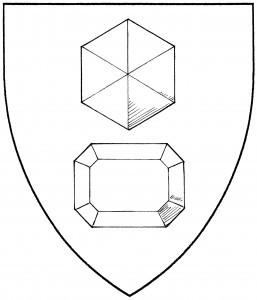Jewelry are items of personal adornment, usually made from precious metals or stones. While they are often shown worn on a human form, they are also used as charges in their own right. Examples from Society armory include cameo busts, wristlets and arm-rings, and necklaces.
Individual gemstones are also sometimes found as charges, as in the civic arms of Beihlstein, 1605 [Siebmacher 226]. Gemstones should be cut in a period style: for instance, the gem in the arms of Beihlstein is hexagonal. In Society armory the step-cut (or emerald-cut), as seen in Holbein’s portraits, is the most common. By default, gemstones are drawn as seen from above – gemstones in profile are considered a step from period practice – and should be solidly tinctured, not chased. Post-period gem cuts, such as the brilliant cut, may not be registered.
The illustration shows an hexagonal gemstone, as in the arms of Beihlstein, and a step-cut gemstone as frequently seen in Society armory. For specific entries, see: brooch, crown, paternoster, ring, torque.
The Order of the Gemme d’Or, of Gyldenholt, bears: Azure, a hexagonal gemstone Or.
Gerold Bright Angel bears: Gules, a double cameo bust within two wings conjoined Or.
Branwen of Cherry Bay bears: Gules, a boar’s-tooth necklace in orle throughout argent.
Lucia Greenstone bears: Argent, a step-cut emerald palewise vert.
